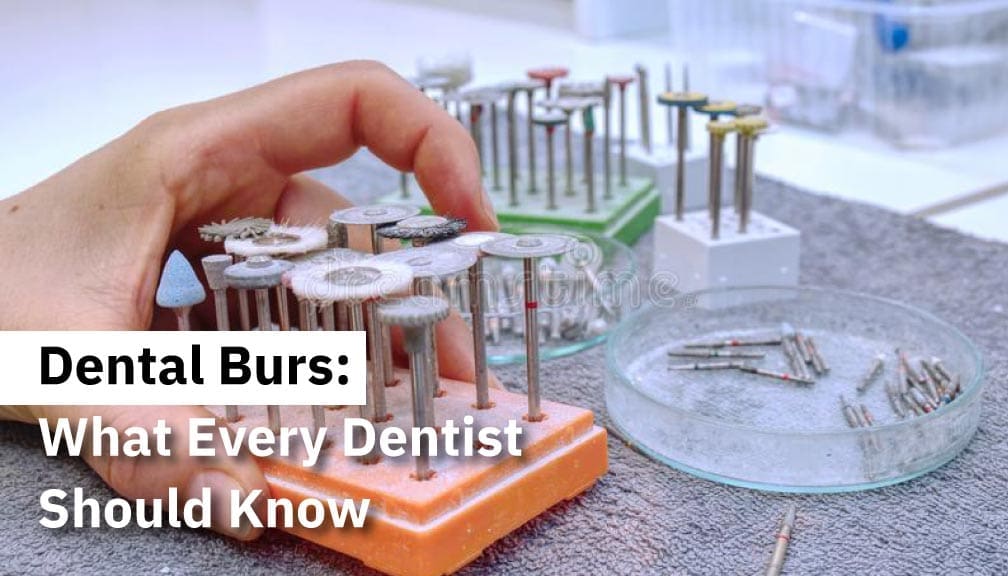
Dental burs are an essential part of everyday general dentistry. The rotary instruments, designed for cutting hard tissues such as tooth enamel or bone, come in various shapes, sizes and grits with two or more sharp-edge blades and multiple cutting edges.
Historically used in the preparation of tooth restoration as essential cutting devices, science and technology have driven the development of the ubiquitous bur to new heights, now encompassing an enormous range of options to deliver a variety of dental procedures.
Rapidly robust and high-quality dental burs are made of steel, stainless steel, tungsten carbide, and diamond grit.
Each bur comes in three parts – the head, the neck, and the shank.
They are used with high-speed handpieces and are usually classified by their shape – cone, round, or spear. In making the right choice of bur, their unique properties are found in the blade angle and positioning, the head’s shape, and the grit’s abrasiveness.
Removal of large amounts of tooth decay, cavity preparation, excavating, and creating access points and channels for blades re: dental extractions.
Removal of tooth structure, rotary intra-oral tooth preparation, and adjustment.
Creating an undercut for filling materials, excavating, trimming, and finishing.
Ideal for precise preparations while limiting debris build-up, such as crown work. Finishing Burs are used in the completion of restorations.
Like sandpaper, dental burs come in different grades of coarseness. In essence, the abrasiveness varies to suit other jobs. The harsher the grit, the more tooth surface will be removed. Finer grits are best suited to work that requires finite detail, such as the smoothing of rough edges or around margins.
The range of burs available to dentists is vast, and selecting the most suitable option can significantly improve clinical casework. Ideally, this can be done at the treatment planning stage.
Pre-sterilized so that they can be used immediately, these burs use quality diamonds for reliable cutting to be used repeatedly.
Made with the most delicate Swiss-made steel shanks, there is an extensive range of shapes and popular sizes. They are strong, durable, and ensure high performance.
Coated with natural diamond, they offer non-clogging spiral dual action using a precision engineered head for faster operation and the least resistance. Ideal for fast bulk reduction and a smooth finish.
Designed for minimal vibration that can lead to handpiece damage and patient discomfort, these are made from heat treatable alloy steels for optimum strength and reliability.
These are highly effective and sharp cutting tools made of hard material. They offer a fast, smooth, vibration-free performance, delivering patient comfort and reduced operative time.
Many of today’s dental burs are available in sterile, single-use packs, ensuring greater infection control – of particular relevance in today’s climate.
Single-use burs are also cost-effective (no need for sterilization), kinder to handpieces (no clogging with debris), and patient-friendly (100% effective every use, thus ensuring greater comfort).
Used in oral surgery, today’s surgical bur is usually made of Tungsten Carbide or Diamond, which means they are strong and durable and offer high performance.
Diamond Burs grind away tooth tissue, cut through the porcelain, and primarily with high-speed handpieces to leave a rough finish.
Tungsten Carbide Burs are also designed for optimum strength, durability, and performance. Three times harder than steel, these smooth tooth structures to a fine finish.
Diamond Burs are well suited to cutting away porcelain restorative material.
Tungsten Carbide Burs chip away at the tooth structure, effectively removing metal restorations, trim, and finish composites.
They can be used for excavating and preparing cavities for fillings, removing old filling material, and contouring bone. They can also remove impacted teeth and separate crowns and bridges. In addition, they leave a smoother surface than a Diamond Bur.
Ceramic Burs are ideal for dentin removal and cavity preparation.
Cylindrical burs are used for the removal of amalgam restorations.
Finishing Burs are designed to add the finishing touches – shape and finer detail – to repairs.
Flat-end Cylinder Burs are used for intra-oral tooth preparation.
Inverted Cone Burs are suitable to undercut access openings for root canals or restorations. They may also be used for flattening pulpal or gingival walls.
Round-end Taper Bur is used for intra-oral tooth preparation and adjustment.
Steel Burs are ideal for cavity preparation and dentine removal.
A Tungsten Carbide Bur in a contra-angle handpiece can be used for interproximal reduction, de-bonding, and predictable and safe resin removal, with minimal damage to tooth enamel and for subsequent enamel polishing.
Ceramic Burs are ideally suited for adjusting acrylic and thermoplastics.
Steel Burs are designed to manipulate acrylic materials, such as dentures and custom trays. They have good edge retention and are resistant to abrasion.
With a wide range of shank styles and head shapes, clinicians can select the best possible option from a wide choice with advanced design features.
Due to the vast array of shapes and sizes of dental burs, standard numbering systems were put in place to identify burs quickly. Two central systems are used; the U.S. and ISO (International Standards Organisation) numbering systems.
The U.S numbering system is most commonly used for carbide burs and is generally a 1 to the 4-digit number depending on the bur.
The ISO numbering system was introduced in 1979, labeling dental burs with a 15-digit code that is broken down into 6 sections:
When purchasing dental burs, it is recommended to address several concerns. The first concern is bur quality.
You should ensure that your dental burs are manufactured from high-quality materials by ISO standards. This will ensure their durability and allow you to provide high-level service to your patients.
Another critical parameter is flexibility. To cover a wide range of patient needs with optimal precision, a wide dental bur “toolkit” is highly recommended.
When you use many types of dental burs, you can exercise a high level of flexibility when treating patients and work with a wide range of materials, speed levels, and head granulations.
It makes your work much more accessible and allows your clinic to offer precision-based services. If you want to increase your dental bur variety, we recommend focusing on bur quality and durability.
These two traits will ensure that your tools will not disappoint you when needed and help you perform your skills with maximum professionalism.
At Dental Assets, we sell numerous types of burs. Our durable supplies products are known for promoting long-term cost-effectiveness. Dental Assets is the place for you if you want to purchase premium-level burs that are both durable and cost-effective.
To buy high-quality dental burs online, please browse our supplies listing. Also, if you have any questions or need more information, don’t hesitate to contact us.

17821 E 17th St
Ste 180
Tustin, CA 92780
*Opt-in / Opt-out
**Customers provide their phone number and consent to receive messages via a form on our website